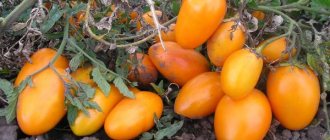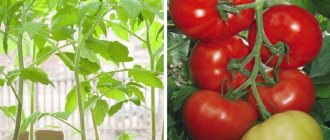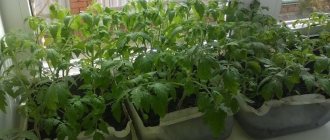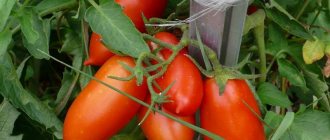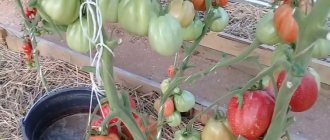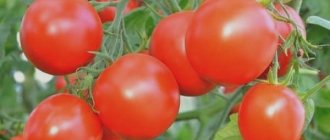How to grow seedlings
The Tsar Bell tomato is grown from seedlings. This takes about 50-60 days. First, the seeds are disinfected and germinated at home. Grown plants are transferred under a film cover or directly into open ground.
Seed preparation
If the seeds are colored in an unusual color, then they do not need additional processing of the grain - they have already been disinfected and kept in a nutrient solution by the manufacturer. If the seeds are purchased from hand or collected from your own harvest, then before sowing the grains are disinfected as follows:
- to destroy pest larvae and eggs, seed material is placed in hot water for 10-15 minutes;
- from possible fungi, mold and rot, the seeds are disinfected in a weak (1%) solution of potassium permanganate (the grains are kept in it for 20-30 minutes).
For accelerated germination and uniform germination, tomato seeds are soaked in a growth stimulator for 15-20 hours. For this purpose the following drugs are used:
- "Energen";
- "Zircon";
- "Baikal-EM1".
The products are sold in specialized stores. They are used strictly according to the instructions indicated on the packaging.
Container and soil
Seedlings are grown in different containers:
- disposable cups;
- wooden or plastic boxes;
- special purchased containers with cells and a lid;
- peat cups or tablets;
- cut milk bottles or cartons.
Seedlings require light nutritious soil, which can be purchased at the store or prepared independently by mixing turf soil, river sand and humus (1:1:1).
Sowing grains for seedlings is carried out in March or April - it all depends on the climatic characteristics of a particular region.
The prepared container is filled with soil, then grooves no deeper than 1.5-2 cm are made in the soil and seeds are sown in them. Cover the top with a small layer of peat, spray it with a spray bottle, cover it with film or transparent glass and place it in a warm place with an air temperature of about 25 ° C.
Growing and care
When shoots appear, the film is removed and the container is sent to a well-lit place - for example, on a windowsill. The room temperature is lowered by several degrees. The optimal air temperature during the day is 20... 22 °C, and at night 10... 15 °C.
As the soil dries, moisten it with a spray bottle. For this purpose, settled and warm water is used. Seedlings should be illuminated for 10-12 hours a day. During short daylight hours, phytolamps are evenly installed above the bushes as additional lighting.
When the seedlings have their third true leaf, the plants are planted in separate containers. But if the tomatoes were originally planted in different pots, replanting is not carried out.
Seedlings are planted in a permanent place of growth no earlier than the end of May - beginning of June. Hypothermia of the root system will reduce the yield, so the plants are transplanted into well-warmed soil of 8-10 cm.
The crop is demanding on lighting, so tomatoes are placed in a well-lit area away from buildings and trees. The bed is prepared in the fall: it is cleared of weeds and remains of cultivated plants, then the soil is sprinkled with humus and dug up.
Landing
When the plants grow to 30 cm, they are transplanted into open ground or a greenhouse. By this time, the bushes will have 6-7 leaves and will bloom. Before planting, 3 lower leaves are removed from the plants to provide the tomatoes with good lighting.
Good predecessors for tomatoes are cabbage, cucumbers, melons, root vegetables, and green manure. Tomatoes are not grown for two years in a row in the same place or after potatoes, eggplants and peppers.
Plants are planted in previously prepared holes. The bushes are placed at a distance of 40 cm from each other, and 60 cm are left between the rows. To ensure that the plants receive more sunlight, the crops are placed in a checkerboard pattern.
The tomatoes are transferred to a permanent place along with a lump of earth. The roots are sprinkled with soil, which is lightly compacted. Then the plants are watered abundantly.
With good care, the crop will not get sick and will produce a good harvest. The plant requires watering, fertilizing and bush formation. After planting, tomatoes are watered for 7-10 days. During this period, tomatoes adapt to a new place.
Moisturize the culture as follows:
- Before the ovaries form, water the tomatoes once a week (4 liters per bush);
- During fruit ripening, tomatoes are moistened twice a week (3 liters of water per plant).
If the Tsar Bell grows in a greenhouse, then the structure must be ventilated after watering to prevent high humidity and the occurrence of fungal diseases.
The crop is watered with settled or rainwater at room temperature. Exposure to cold will slow down plant development.
Tomatoes are fertilized several times a season. At the beginning of the growing season, plants are given fertilizers containing nitrogen. In the future, to strengthen the root system and improve the taste of the fruit, the bushes are fertilized with potassium and phosphorus.
Tomatoes are fed according to this scheme:
- 14 days after planting the plants in a permanent place, the crop is fertilized with liquid mullein diluted with water in a ratio of 1:15;
- after another two weeks, the tomatoes are fed with a solution of superphosphate and potassium salt (25 g of each product per bucket of water);
- The next fertilization is carried out during fruit ripening with a solution of potassium humate (1 tbsp per 10 liters of water).
Wood ash is a good substitute for mineral fertilizers. It is embedded in the soil or added to water for irrigation.
The variety is formed into 1-2 stems. The stepsons that grow from the leaf sinus are removed. The first pinching is carried out after transplanting the plants into open ground or a greenhouse. Once a week, the lateral shoots of the plants are broken off, leaving stumps up to 3 cm. During the period of fruit ripening, the lower leaves of the plants are removed. This way the bushes will be better ventilated, and as they grow in the greenhouse, the humidity level will decrease.
In order for oxygen to penetrate to the root system, the soil around the plants is loosened to a depth of 5 cm, in row spacing - 10 cm. The activity is carried out 12-24 hours after watering. Along with loosening, weeds are removed so that they do not take away nutrients from the tomatoes. After aeration, the soil is mulched with compost. This will provide the plants with additional nutrition and help retain moisture in the soil longer in hot weather.
The agricultural technology of the Tsar Bell variety is no different from growing other tomatoes. To obtain a bountiful harvest, plants are provided with timely watering and regular fertilizers.
Diseases and pests
The variety has strong immunity to most nightshade diseases. Tomato Tsar Bell has good resistance to fungi and diseases such as:
- verticillium;
- fusarium;
- late blight
Tomato resistance to diseases is high, but to be sure, experienced vegetable growers carry out preventive measures. To reduce the risk of plant disease, the soil is disinfected with a hot solution of potassium permanganate.
After transplanting the tomatoes to a permanent place, the bed is sprayed with any fungicide, for example:
- "Quadris";
- "Acrobat";
- "Ridomil";
- "Agate 25K";
- "Maksim".
The tomato has average resistance to pests. Most often, the crop is affected by insects such as whiteflies, wireworms, and aphids.
To repel insects, peat and humus are added to the soil. To prevent pests from breeding, weeds are regularly removed. Treat the soil with a light soap solution - this will help get rid of aphids. Wood ash or tobacco dust is used against slugs. Folk remedies are replaced with insecticides, for example, "Aktellik", "Confidor", "Karate" or "Fitoverm".
Diseases and pests
Since the Nikola tomato is susceptible to blossom end rot, bacterial black spot and late blight, prevention should be observed:
- It is necessary to soak the seed material in a manganese solution or using other disinfectants;
- Conduct regular inspection of plantings for diseases;
- Periodically treat the plantings with Bordeaux mixture or other preparations to protect the tomato from fungal diseases.
The most common pests are beetles, mites, caterpillars, slugs, and mole crickets. They do not allow the tomato crop to develop normally, and also cause significant harm to the vegetable crop. Insecticidal preparations, which can be purchased in specialized stores, will help in the fight against them.
The use of folk remedies will be no less effective. An aqueous solution of laundry soap will create an unfavorable environment for uninvited guests.
Tomato Bells of Russia: variety description, photo, yield
The Tsar Bell is unpretentious in care, except for the need for regular fertilization to increase productivity. The variety received high marks, and the high transportability of the fruits makes them suitable for growing for sale.
Vladimir, Krasnodar: “Last year I tried to grow the Tsar Bell tomato variety for the first time. There were no difficulties. The tomatoes grew large, as in the photo of the package with seeds. The vegetables taste sweet, without much sourness. To obtain an abundant harvest of large-fruited tomatoes, the crop was grown in a greenhouse.
READ MORE: Purple candle tomato characteristics and description of the variety
Ivan, Kursk: “Once I saw a neighbor’s large-fruited tomatoes. I also wanted to grow the same ones. He advised me to plant the Tsar Bell variety. I plant seedlings in open ground. The culture was practically not sick. I fed the tomatoes 3 times. Watered the plants regularly. What I especially liked was the early ripening of the variety. The vegetables, although large, do not crack. The tomatoes are tasty and meaty. I liked the Tsar Bell, I recommend it to everyone.”
“Tsar Bell” is one of the priority tomato varieties of Russian selection. It is famous for its extraordinary large-fruited size, as well as its ease of care and early ripening of delicious, selected tomatoes.
Tsar Bell has an average ripening time, which is 100-110 days from the moment the seeds are sowed for seedlings. Usually, with the correct growing technique, gardeners begin to feast on sweet, aromatic fruits already in July.
This variety is characterized by a determinate type of bush, that is, the plant itself stops growing after the formation of all flower clusters. The plants grow short, compact, up to one meter high (in a greenhouse the bush can stretch up to 1.5 meters).
The large, strong stem is covered with 7-9 flower clusters with large, dark green, simple-shaped leaves. The first ovary is formed above the ninth leaf, the next ones - after 1-2 leaves. The fruits are formed 4 pieces per cluster.
Since the bush grows powerful and each cluster holds several heavy fruits, it is recommended to use supports and a garter (in some cases, each cluster is tied). For a better harvest, it is recommended to form the plant into two stems.
The main distinguishing feature of the variety is the giant heart-shaped fruits, which weigh 800 grams (the average is 400-600 grams). Tomatoes are characterized by a bright red color (sometimes with a crimson tint) with a dense, smooth skin and a fleshy interior. Tomatoes have both a sweetish tint and sourness, but in moderation.
Tsar Bell is a salad type of tomato. It goes well for slicing, as well as for preparing second courses. But these tomatoes exhibit their taste best when fresh. But for canning it is better to use other varieties.
The yield of the variety is average. Usually about 8-9 kilograms are collected from one square meter. However, with increasing doses of fertilizers, the yield can increase by 1.5-2 times.
Tomatoes ripen quickly after being picked and do not crack or get soggy. They do not lose their appearance during long-term transportation, and are also stored for a long time.
- large-fruited;
- fruits are stored for a long time;
- easy to care for;
- withstands temperature changes;
- tomatoes do not lose their excellent appearance during transportation;
- is immune to major diseases.
Tsar Bell tomatoes are grown through seedlings, which can be planted both in open ground and in a greenhouse. You need to sow the seeds at the end of March or early April.
Before planting, seeds are usually soaked in a disinfectant composition and sprayed with a growth stimulant. Before planting the seeds in the soil, they are placed in warm, damp fabric material for a couple of days. During this time, the seeds will swell, and after planting in the ground, sprouts will appear very quickly, within 3-4 days.
The sowing soil should be airy and well drained. To do this, the earth is mixed with humus and a little river sand is added, which improves the conductivity of water and air. The soil is also disinfected by soaking it in manganese infusion or calcining it in the microwave or oven.
Seeds are sown in a shallow container, deepening the seeds by 1-1.5 centimeters. Leave at least two centimeters between the seeds so that the roots can develop freely.
After sowing, carefully moisten the soil, avoiding washing out the seeds. Then the containers are covered with film and placed in the shade. Due to the resulting greenhouse effect, seedlings will be fast and simultaneous. When all the shoots hatch, the film is removed, and the boxes with seedlings are placed in a lighted place (window sill).
Care during the seedling period:
- The air temperature should be 22-25 degrees Celsius during the day and 15 degrees at night.
- Seedlings should be illuminated for at least 16 hours a day.
- The soil should always be semi-moist.
- To prevent the seedlings from rotting, it is necessary to carry out periodic ventilation, avoiding cold air currents.
- Young seedlings need to be watered by sprinkling. The water should only be warm and settled.
As soon as two leaves appear on the bushes, the seedlings are picked, that is, planted in separate containers. If the plants are wilted and look sickly, the soil is fertilized with Kornerost.
A couple of weeks before transplanting tomatoes into the garden, the seedlings begin to be hardened so that they can withstand transportation painlessly. To do this, the bushes are taken out onto the veranda and kept there for an hour at first, then the time is increased. And in the last two days, the seedlings can even be put outside for the whole day.
Planting is usually done in May, when warm, dry weather sets in outside and the soil warms up to a depth of 8-10 centimeters. By this moment, the bushes will have time to grow up to 30 centimeters in height, and at least 7-9 leaves will appear on them and flower ovaries will even begin to form.
The soil for tomatoes has been prepared since autumn. When digging, add organic matter (but not fresh manure), as well as nitrogen and phosphorus-potassium fertilizers.
The bed for tomatoes is planted in two rows, with 50-60 centimeters left between them. Water is generously poured into the prepared hole, and the ground is sprinkled with ash and complex fertilizer. Before planting, 2-3 lower leaves are removed from the plant so that no shadow is formed under the bush. It is better to plant by transshipment, removing the bush from the container along with a lump of earth. This way, the likelihood of injury to the fragile rhizome will decrease significantly. After planting, the bush is covered with earth and then watered again.
Care after landing
Tomatoes of the Tsar Bell variety are quite easy to care for. It is necessary to carry out the simplest agricultural practices, such as watering, weeding, loosening, as well as complicated manipulations - applying fertilizers, forming bushes and garters.
The variety is medium or mid-early in terms of ripening time, indeterminate in growth pattern. These plants are suitable for growing in greenhouses and temporary shelters.
Characteristic
Most vegetable growers believe that the first harvest can be harvested 4 months after sowing the seeds. The plant grows in height to a maximum of 1.5 m. The first flower cluster is formed above 7-9 leaves, then after 3 leaves. One cluster can contain from 7 to 9 fruits.
Description of the fruits: they are red in color and have an elongated shape. Their weight is from 150 to 200 g. The pulp is fleshy and has an excellent taste.
Advantages
- The fruits are universal in use.
- The shape is unusual.
- Plants require little care.
- Bushes of this variety are resistant to temperature changes.
- Good immunity to many diseases.
- The fruits are resistant to cracking.
- High transportability and keeping quality of fruits.
- The fruits can be used both fresh and for processing.
- Seeds for seedlings should be sown 50-60 days before planting at the fruiting site. If possible, containers with sown seeds should be kept at a temperature of 24-25 degrees.
- It should be planted in a permanent place in such a way that per 1 sq. There were 3 plants per meter.
- Bushes must be tied to trellises or stakes.
- Plants of this variety are considered to be well responsive to watering and fertilizing. Watering is usually recommended approximately once a week.
Top dressing
It is also necessary to feed regularly, but there is an opinion that it is enough to feed bellflower bushes 3-4 times per season. Such a frequency of fertilizing is possible only if the planting holes are well filled and on soils with a high level of fertility. In order for the plants to do without fertilizing, for example, before the flowering period of the 3rd flower cluster, it is advisable to add at least one long-acting fertilizer to the holes.
For those gardeners who rarely visit the city, we can recommend adding humus with a small amount of superphosphate. After the third cluster of flowers blooms, tomato plants may need feeding in many areas. In such cases, you can use some organic fertilizers, for example, infusions of manure or herbs, extracts from vermicompost, and mineral ones, such as Zdraven, Mortar, Fertika. These fertilizers contain a large list of nutritional elements, selected in physiologically based proportions.
Plant protection
Bluebell tomatoes are naturally disease resistant. However, with massive outbreaks and large numbers of infections, certain fungal diseases can also occur, in particular late blight, cladosporiosis, and macrosporiosis. To prevent infection, it is advisable to spray three times with biological products, such as Alirin-B, Baktofit, and improve the soil by spilling a suspension of biofungicides such as Trichoderma viride, Sporobacterin, as well as the above agents.
READ MORE: Tomato pink impression characteristics and description of the variety, yield with photos
It is permissible to use Farmayod solution as a potent disinfectant. To increase your own resistance to fungal infections, it is advisable to use immunomodulators (Immunocytophyte, Narcissus, Ecogel, humates, Silk, NV-101, polymicrofertilizers (Uniflor-micro, Aquadon-micro, Orbigum, Siliplant), biological products of the EM series (Baikal EM1, Vostok EM1) .
Tomato Tsar Bell: characteristics and description, reviews, photos, variety yield
Description
Mid-early determinate variety. The height of the bush is 50–60 cm. The leaves are small, light green. The plant is medium leafy. Since during the fruiting period a large number of fruits are set on the plant, it is recommended to tie the stems. When using supports, the risk of damage is minimal.
The shape of the fruits resembles a pear with an elongated sharp tip. The clusters consist of 6–7 fruits weighing 50–60 g. Ripe fruits are colored pink-scarlet. The fruits are used for preparing salads, canned whole fruits and decorating dishes.
The core is juicy and dense. There are few seed chambers. The tomatoes taste sweet with barely noticeable sourness. Thanks to the strong skin, the fruits are resistant to cracking, tolerate long-term transportation and are stored for a long time.
The variety is intended for cultivation in open ground. In case of rainy or cold summers, tomatoes are grown in a greenhouse.
Bluebell tomatoes have the following benefits:
For abundant fruiting, the plant needs to be provided with nutritious soil and planting.
To obtain tomato seedlings, seeds are sown after May 15 in containers filled with loose substrate. To create a greenhouse effect, the container is covered on top with a piece of glass or film. After the seedlings emerge, the shelter is removed, the box is placed in a lighted place and the temperature is reduced by several degrees. In a cool environment, the sprouts do not stretch.
Subsequent care for tomatoes includes the following manipulations:
- Watering. Tomatoes are one of those crops that suffer from high humidity. To prevent the development of fungal diseases, plants are watered abundantly, but rarely. If the summer is dry, the bushes are watered once a week. Water consumption per adult plant is 3–4 liters. After each watering or heavy rain, the soil is loosened and the bushes are lightly hilled.
- Dive. Plants are transplanted from a large container into separate pots at the age of 2-3 true leaves, and to a permanent place - after the formation of 5 leaves.
- Stepsonning and garter. The best scheme for growing a high-yielding variety is considered to be the formation of one or two stems. In the first case, all lateral shoots are removed, in the second, two stems are left. To prevent the plant from getting sick, the stepsons are removed gradually. Tie the plants to metal or wooden stakes immediately after they take root in a permanent place.
- Feeding. During the first period of development, tomatoes are fed with organic or mineral fertilizers with a balanced amount of nitrogen, phosphorus and potassium. After the plants enter the flowering and fruiting phase, only mixtures are added, which consist mainly of potassium and phosphorus. Feeding is carried out at intervals of 2 weeks.
Reviews
Judging by the opinions of beginners and experienced gardeners, Bell occupies a worthy place among all other varieties and hybrids. Tomatoes have a pleasant sweet taste and dense flesh, which allows them to be used in salads and canned food. Plants show good productivity in the northern regions.
Have you ever grown the Bell variety? Will you jail him again? Leave reviews so that other vegetable growers do not make a mistake in their choice.
What is a Bell tomato?
The Bell variety is an indeterminate variety and is suitable for growing in greenhouse conditions. Tomatoes can also be grown in open ground, but temporary shelter will be necessary. The fruits have a fleshy pulp structure that contains a small amount of seeds. Reviews from buyers and farmers who grow this variety indicate that Bell has a good taste and can easily be transported over distances.
Usually the Bell tomato bush reaches a height of 1.5 m. The first inflorescence appears above the 7th, 8th or 9th leaf. The remaining inflorescences are laid in increments of 3 leaves. Each inflorescence can bring the farmer 7-9 ripe fruits. Tomatoes are characterized by a rich red color; the shape of the tomatoes is elongated, slightly pointed at the bottom.
The weight of 1 fruit varies between 150-200 g, however, individual tomatoes reach 350 g. Such tomatoes are widely used in cooking: fresh, in various salads, for making sauces and juice. In addition, Bluebell is suitable for canning due to the structure of the skin.
The description of the variety can be reduced to several basic parameters:
- Red color;
- obtaining the first harvest in 4 months;
- average weight 150-200 g;
- grown in closed greenhouses or under a canopy;
- can be used in any culinary dishes.
Tomato Bells of Russia: variety description, photo, yield
This tomato variety belongs to the group of mid-early tomatoes; the fruits begin to ripen after about 110 days (in a greenhouse - after 90 days). The bushes are hung with trusses with oblong tomatoes - dense, bright red, tasty.
The originator of the variety is the Rostock agricultural company, the tomato is included in the State Register and is recommended for cultivation in open ground. In regions with a harsh climate, it is still better to plant plants in shelters; you can use both greenhouses and arcs with film, hotbeds, and tunnels.
You can grow it on balconies and loggias, having previously taken care of bulk containers and nutritious soil.
A mid-early tomato grows no more than 60 cm, with few leaves. The color of the leaf blades is light green, the shape is simple. A determinate variety needs shaping and pinching. You can grow it in 3-4 stems, but at the same time follow the planting pattern. It is important that the plants do not obscure each other, and that the fruits are provided with good lighting.
The first brush is usually formed above the fourth or fifth leaf, all subsequent ones - through the leaf. The clusters of this tomato are simple; each plant usually bears up to 8 fruits.
The tomatoes are leveled, the approximate weight is about 50-60 grams. Their shape is elongated, similar to small “pears” with a pronounced nose at the top. The skin is dense, at first it has a rich green color, as the fruits ripen they become pink-red.
Up to 5 clusters can be formed on each trunk, so the bush at the time of mass fruiting looks very decorative. Under the glossy skin is juicy pulp with a dense structure. There are very few seeds, so when collecting your own seed material you need to take this into account.
The taste is excellent. The tomato is sweet, with a pleasant aroma and slightly perceptible sourness. The taste very much depends on care, the presence of sun, and proper watering.
These tomatoes look great in a variety of assorted varieties: with cucumbers, zucchini, and squash. The small shape of the fruit allows them to be used for whole-fruit preservation. Thanks to their thick skin, tomatoes retain their shape and do not crack, and they are even tastier when prepared than fresh.
The fruits of this variety are also used fresh, for decorating salads, various dishes, and as slices.
The Kolokola Rossii variety has few “cons”, and that is why it is valued by many gardeners. Firstly, the variety is demanding in terms of soil nutrition, and secondly, despite its small height, it needs pinching. This method will eliminate the thickening of the plant and will ensure faster formation and ripening of fruits on the clusters.
There are many more advantages, and among them:
- high yield of the variety;
- unpretentiousness to weather conditions;
- the ability to grow this tomato both in shelters and in open ground;
- high taste of tomatoes;
- unusual shape;
- the ability to use whole fruits for preservation;
- low maintenance requirements;
- resistance to major diseases.
READ MORE: Vityaz apple tree: description of the variety and characteristics, productivity and selection history
This tomato variety tolerates minor temperature drops well and does not reduce yields. Gardeners note that even in a bad and lean summer for tomatoes, this tomato still forms a lot of trusses.
Tomatoes are grown through seedlings, the seeds are sown in mid-March (when planted in ridges) or in early March when grown in greenhouses.
Growing seedlings
In order for the seedlings to be strong and healthy, and then the plants not to get sick, it is necessary to take care of the preparation of the seed material.
- disinfection (use potassium permanganate);
- soaking in compositions with special growth stimulants;
- germination.
You can also harden the seeds by placing them on the refrigerator shelf for a couple of days and soaking them in an infusion of ordinary wood ash instead of a purchased stimulant.
Boxes or glasses are prepared in advance and filled with soil. For tomatoes, both purchased soil mixtures and home-made soil mixtures are suitable. When purchasing soil in a store, be sure to familiarize yourself with its composition, since you will need to add soil and a leavening agent (for example, river sand) to peat soil.
The soil must also be disinfected, and sowing of seeds is carried out only 3-4 days after the procedure. To germinate tomato seeds, it is important to ensure a stable temperature: 25ºC… 27ºC. Then, after germination, the temperature is reduced to 17ºC... 18ºC (for 4-5 days) so that the seedlings do not stretch.
Further care is carried out at a temperature of 23ºC… 25ºC. It is advisable to avoid sudden changes, and when ventilating the room, prevent cold air from entering the plants. Water with warm water, just the soil itself, trying not to get it on the seedlings. In order to protect tomatoes from blackleg, it is recommended to sprinkle ash or sand on the surface of the soil.
As soon as the seedlings have 2-3 true leaves, they dive. Many gardeners prefer to grow tomatoes without picking, immediately sowing the seeds in separate bowls and then gradually pouring soil into cups. Others, on the contrary, make not one, but two picks, each time carefully replanting the plants into larger containers.
Fertilizing for seedlings is carried out as needed and only after diving. It is advisable to use complex fertilizers or ready-made special formulations (KEMIRA).
Grown seedlings can be hardened off, and if the weather permits, take them outside. And about 10-12 days before planting tomatoes in shelters, hardening is mandatory. This will help the tomatoes quickly adapt to new conditions when planted on ridges or in a greenhouse.
Tomato care
Tomatoes are planted only when warm weather arrives. In shelters, the soil warms up earlier, so the timing shifts by about 1.5-2 weeks. The usual time for the middle zone is May, and gardeners determine the specific dates based on the characteristics of the current year.
The planting scheme for the Bells of Russia variety is three plants per square meter. The seedlings of this variety are compact, but later the bushes grow, especially for tomatoes in a greenhouse. You can plant 4 bushes on the beds.
The soil should be filled with humus and superphosphate in the fall. Good results are obtained by adding wood ash to tomatoes. It is also used to feed plants during the growing season, and also as a means of protection against diseases and pests.
You can start feeding tomatoes approximately 18-20 days after planting. They use organic matter (mullein, poultry droppings), which is diluted with water, as well as mineral fertilizers. It is recommended to give preference to fertilizers that contain more potassium and phosphorus. From the moment the fruits form, nitrogen is added to a minimum or eliminated completely. With excessive doses of this element, tomatoes lose their ovaries, the plants begin to “fatten”, and leaves quickly grow to the detriment of the fruits.
For tomatoes that grow in the garden, the stepsons are removed approximately once every 10 days; for greenhouse plants, the procedure is carried out more often - twice a week. If the shoots are not removed in time, the greenhouse will quickly turn into a “jungle”, and the formation of fruits will proceed slowly. This will affect the overall yield of the variety.
The stumps are not removed completely; they are left when the stumps up to 1.5–2 cm long are broken out.
When forming a bush, tomatoes of this variety are usually left with 3-4 stems; with adequate nutrition, the plant can form a sufficient number of brushes on each stem. The strongest and stockiest stepson, which grows under the first tomato flower cluster, is left as the second stem. This creates two trunks, and all other shoots are regularly removed. When growing a bush with three stems, one more stepson is left.
The variety Bells of Russia needs a garter. It is recommended to tie up both the main stems and branches with clusters at the time of mass fruiting.
This tomato is quite resistant to various types of infections, but you should not forget about preventive measures. Even the most resistant varieties can become diseased if certain agricultural practices are not followed:
- Alternate crops on the site. Tomatoes grow best after onions, spinach, legumes, and cucumbers.
- Disinfect soil, equipment, containers for growing seedlings (if they are used repeatedly), and be sure to disinfect the seeds themselves.
- Ventilate greenhouses, avoiding high humidity and too high temperatures in the shelter.
- Remove all weeds.
- Comply with fertilizer application standards.
- Treat plants with herbal infusions, which are excellent for preventive measures.
It is also important to purchase healthy seeds, and when collecting your seed material, take it only from healthy plants.
Treating tomatoes with soap solutions, dusting with ash, or a composition with ammonia saves from pests.
Harvest
Like many other tomato varieties, Kolokolov Rossii does not have to wait for the fruits on the bush to fully ripen. As soon as the tomatoes begin to turn pink, they can be removed and ripened at home.
This will allow subsequent batches of tomatoes to form on the bushes faster, and the yield will be higher. Leaving tomatoes to ripen on the bush, you thereby slow down the growth of other fruits.
These tomatoes are suitable for storage, can withstand transportation, and do not lose their taste and commercial qualities.
For two years now I have been very pleased with the Bell of Russia variety. For a very long time I was looking for a variety that would be suitable for canning. Many varieties were good, but they usually taste sour, and I didn’t like that. I planted this variety at random, I liked the description and picture on the bag, and the seller in the store praised it.
It grew in my greenhouse, grew to 50 cm, and how it began to bloom and knit brushes! There were from 30 to 60 tomatoes on the bushes at the same time; I picked them both ripe and green. Then they arrived perfectly in boxes at home. The fruits are not small, not cherry, but just for preservation. I ate little fresh; I have other varieties for salads, but these were the ones I used for pickling and pickling. Now this is my favorite variety for canning.
In the OG I plant the Kolokola Rossii variety and use it for marinades. Serve only this tomato to your spouse, and indeed, the tomatoes turn out very tasty. I don’t plant them in a greenhouse; they grow well just like that, in beds. In May I cover it with lutrasil, immediately after planting, and then I remove the material and grow like this. I cover it again in August, if cold snaps begin. This variety bears fruit for a long time, I pick the tomatoes green and ripen them at home. I select one bush and take fruits from it for seeds.

